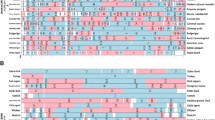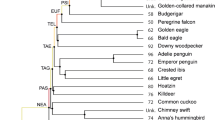Abstract
The karyotypes of birds, turtles and snakes are characterized by two distinct chromosomal components, macrochromosomes and microchromosomes. This close karyological relationship between birds and reptiles has long been a topic of speculation among cytogeneticists and evolutionary biologists; however, there is scarcely any evidence for orthology at the molecular level. To define the conserved chromosome synteny among humans, chickens and reptiles and the process of genome evolution in the amniotes, we constructed comparative cytogenetic maps of the Chinese soft-shelled turtle (Pelodiscus sinensis) and the Japanese four-striped rat snake (Elaphe quadrivirgata) using cDNA clones of reptile functional genes. Homology between the turtle and chicken chromosomes is highly conserved, with the six largest chromosomes being almost equivalent to each other. On the other hand, homology to chicken chromosomes is lower in the snake than in the turtle. Turtle chromosome 6q and snake chromosome 2p represent conserved synteny with the chicken Z chromosome. These results suggest that the avian and turtle genomes have been well conserved during the evolution of the Arcosauria. The avian and snake sex Z chromosomes were derived from different autosomes in a common ancestor, indicating that the causative genes of sex determination may be different between birds and snakes.
Similar content being viewed by others
References
Ayres M, Sampaio MM, Barros RMS, Dias LB, Cunha OR (1969) A karyological study of turtles from the Brazilian Amazon Region. Cytogenetics 8: 401–409.
Beçak W, Beçak ML, Nazareth HRS, Ohno S (1964) Close karyological kinship between the reptilian suborder Serpentes and the class Aves. Chromosoma 15: 606–617.
Beçak W, Beçak ML (1969) Cytotaxonomy and chromosomal evolution in Serpentes. Cytogenetics 8: 247–262.
Belterman RHR, de Boer LEM (1984) A karyological study of 55 species of birds, including karyotypes of 39 species new to cytology. Genetica 65: 39–82.
Bickham JW, Baker RJ (1976) Chromosome homology and evolution of emydid turtles. Chromosoma 54: 201–219.
Bickham JW, Bull JJ, Legler JM (1983) Karyotypes and evolutionary relationships of trinychoid turtles. Cytologia 48: 177–183.
Bull JJ, Moon RG, Legler, JM (1974) Male heterogamety in kinosternid turtles (genus Staurotypus). Cytogenet Cell Genet 13: 419–425.
Burt DW (2002) Origin and evolution of avian microchromosomes. Cytogenet Genome Res 96: 97–112.
Burt DW, Bumstead N, Bitgood JJ, Ponce de Leon FA, Crittenden LB (1995) Chicken genome mapping: a new era in avian genetics. Trends Genet 11: 190–194.
Burt DW, Bruley C, Dunn IC et al. (1999) The dynamics of chromosome evolution in birds and mammals. Nature 402: 411–413.
Cao Y, Sorenson MD, Kumazawa Y, Mindell DP, Hasegawa M (2000) Phylogenetic position of turtles among amniotes: evidence from mitochondrial and nuclear genes. Gene 259: 139–148.
Carr JL, Bickham JW (1981) Sex chromosomes of the Asian black pond turtle, Siebenrockiella crassicollis (Testudines: Emydidae). Cytogenet Cell Genet 31: 178–183.
Carver EA, Stubbs L (1997) Zooming in on the human-mouse comparative map: genome conservation re-examined on a high-resolution scale. Genome Res 7: 1123–1137.
Caspers G-J, Reinders G-J, Leunissen JAM, Wattel J, de Jong WW (1996) Protein sequences indicate that turtles branched off from the amniote tree after mammals. J Mol Evol 42: 580–586.
De Boer LEM (1984) New developments in vertebrate cytotaxonomy VIII. A current list of references on avian karyology. Genetica 65: 3–37.
Graves JAM, Shetty S (2000) Comparative genomics of vertebrates and the evolution of sex chromosomes. In: Clark MS, ed. Comparative Genomics. Boston, Dordrecht, London: Kluwer Academic Publishers, pp 153–205.
Graves JAM, Shetty S (2001) Sex from W to Z: Evolution of vertebrate sex chromosomes and sex determining genes. J Exp Zool 290: 449–462.
Groenen MAM, Cheng HH, Bumstead N et al. (2000) A consensus linkage map of the chicken genome. Genome Res 10: 137–147.
Hasegawa M, Thorne JL, Kishino H (2003) Time scale of eutherian evolution estimated without assuming a constant rate of molecular evolution. Genes Genet Syst 78: 267–283.
Hedges SB, Poling LL (1999) A molecular phylogeny of reptiles. Science 283: 998–1001.
International Chicken Genome Sequencing Consortium (2004) Sequence and comparative analysis of the chicken genome provide unique perspectives on vertebrate evolution. Nature 432: 695–716.
Iwabe N, Hara Y, Kumazawa Y et al. (2005) Sister group relationship of turtles to the bird–crocodilian clade revealed by nuclear DNA-coded proteins. Mol Biol Evol 22: 810–813.
Janke A, Arnason U (1997) The complete mitochondrial genome of Alligator mississippiensis and the separation between recent Archosauria (birds and crocodiles). Mol Biol Evol 14: 1266–1272.
Jones KW, Singh L (1985) Snakes and the evolution of sex chromosomes. Trends Genet 1: 55–61.
King M, Rofe R (1976) Karyotypic variation in the Australian Gekko Phyllodactylus marmoratus (Gray)(Gekkonidae: Reptilia). Chromosoma 54: 75–87.
Kohn M, Kehrer-Sawatzki H, Vogel W, Graves JAM, Hameister H (2004) Wide genome comparisons reveal the origins of the human X chromosome. Trends Genet 20: 598–603.
Kumar S, Hedges SB (1998) A molecular timescale for vertebrate evolution. Nature 392: 917–920.
Kumazawa Y, Nishida M (1999) Complete mitochondrial DNA sequences of the green turtle and blue-tailed mole skink: statistical evidence for Archosaurian affinity of turtles. Mol Biol Evol 16: 784–792.
Mannen H, Li SS-L (1999) Molecular evidence for a clade of turtles. Mol Phyl Evol 13: 144–148.
Matsuda Y, Chapman VM (1995) Application of fluorescence in situ hybridization in genome analysis of the mouse. Electrophoresis 16: 261–272.
Mindell DP, Sorenson MD, Dimcheff DE, Hasegawa M, Ast JC, Yuri T (1999) Interordinal relationships of birds and other reptiles based on whole mitochondrial genomes. Syst Biol 48: 138–152.
Nanda I, Shan Z, Schartl M et al. (1999) 300 million years of conserved synteny between chicken Z and human chromosome 9. Nat Genet 21: 258–259.
Nanda I, Zend-Ajusch E, Shan Z et al. (2000) Conserved synteny between the chicken Z sex chromosome and human chromosome 9 includes the male regulatory gene DMRT1: a comparative (re)view on avian sex determination. Cytogenet Cell Genet 89: 67–78.
Pieau C, Dorizzi M (2004) Oestrogens and temperature-dependent sex determination in reptiles: all is in the gonads. J Endocrinol 181: 367–377.
Pieau C, Dorizzi M, Richard-Mercier N (1999) Temperature-dependent sex determination and gonadal differentiation in reptiles. Cell Mol Life Sci 55: 887–900.
Raymond CS, Shamu CE, Shen MM et al. (1998) Evidence for evolutionary conservation of sex-determining genes. Nature 391: 691–695.
Raymond CS, Parker ED, Kettlewell J et al. (1999) A region of human chromosome 9p required for testis development contains two genes related to known sexual regulators. Hum Mol Genet 8: 989–996.
Sarre SD, Georges A, Quinn A (2004) The ends of a continuum: genetic and temperature-dependent sex determination in reptiles. BioEssays 26: 639–645.
Sasaki M, Takagi N, Nishida C (1984) Current profiles of avian cytogenetics, with notes on chromosomal diagnosis of sex in birds. The Nucleus 27: 63–73.
Sato H, Ota H (2001) Karyotype of the Chinese soft-shelled turtle, Pelodiscus sinensis, from Japan and Taiwan, with chromosomal data for Dogania subplana. Cur Herpetol 20: 19–25.
Schmid M, Nanda I, Guttenbach M et al. (2000) First report on chicken genes and chromosomes 2000. Cytogenet Cell Genet 90: 169–218.
Shetty S, Griffin DK, Graves JAM (1999) Comparative painting reveals strong chromosome homology over 80 million years of bird evolution. Chromosome Res 7: 289–295.
Shetty S, Kirby P, Zarkower D, Graves JAM (2002) DMRT1 in a ratite bird: evidence for a role in sex determination and discovery of a putative regulatory element. Cytogenet Genome Res 99: 245–251.
Singh L (1972) Evolution of karyotypes in snakes. Chromosoma 38: 185–236.
Smith CA, Sinclair AH (2004) Sex determination: insights from the chicken. BioEssays 26: 120–132.
Suzuki T, Kurosaki T, Shimada K et al. (1999) Cytogenetic mapping of 31 functional genes on chicken chromosomes by direct R-banding FISH. Cytogenet Cell Genet 87: 32–40.
Takagi N, Sasaki MA (1974) Phylogenetic study of bird karyotypes. Chromosoma 46: 91–120.
Wallis JW, Aerts J, Groenen MAM et al. (2004) A physical map of the chicken genome. Nature 432: 761–764.
Zardoya R, Meyer A (1998) A Complete mitochondrial genome suggests diapsid affinities of turtles. Proc Natl Acad Sci USA 95: 14226–14231.
Author information
Authors and Affiliations
Corresponding author
Additional information
Matsuda and Nishida-Umehara contributed equally to this work.
Rights and permissions
About this article
Cite this article
Matsuda, Y., Nishida-Umehara, C., Tarui, H. et al. Highly conserved linkage homology between birds and turtles: Bird and turtle chromosomes are precise counterparts of each other. Chromosome Res 13, 601–615 (2005). https://doi.org/10.1007/s10577-005-0986-5
Received:
Accepted:
Published:
Issue Date:
DOI: https://doi.org/10.1007/s10577-005-0986-5




